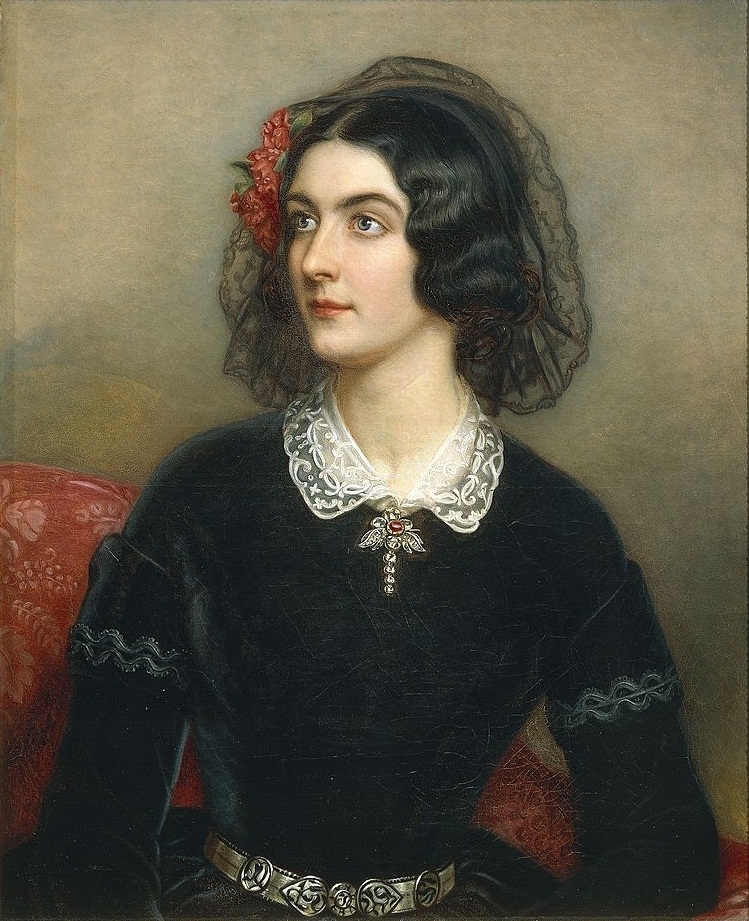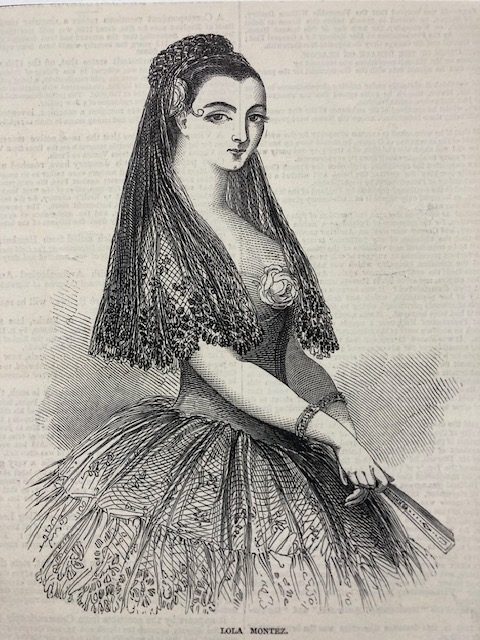By Sarah McCleave
The 1820 birth in Limerick of a daughter, Eliza Gilbert, to the recently-wed 14-year old Eliza Olivier and ensign Edward Gilbert would seem to augur nothing more than the swift maturation of a very young mother. And yet Eliza the younger would grow up to become one of the most notorious actress-dancers of the mid-nineteenth century. By adopting an entirely spurious Spanish identity as Lola Montez, this flamboyant Irishwoman cultivated an unconventional performance style and a completely unfettered persona both on and off stage. Her subsequent travels across three continents left a trail of abdication, bigamy, and scandalised spectators in her wake, exerting a fascination on the press and the public that has retained some traction even into the twenty-first century. This first in a series of blog posts will cover her youth and European career.
Eliza’s metamorphosis into the famed Lola Montez could not have been predicted. She was not born into a theatrical family – indeed, her mother, Eliza the elder, was the youngest of four children born of the Cork-based M.P. Charles Silver Olivier and one Mary Green. Olivier married an heiress the year Eliza was born (1805), but arranged that she and her elder sister were bound to a milliner so they could support themselves. Eliza instead fell for the British officer Edward Gilbert, whose own origins are unknown – but in any case his family had no contact with his young wife or daughter, for he and his young wife remained in Ireland until the toddler Eliza was around three years of age, at which time Gilbert arranged to join the Forty-fourth Foot Regiment in India. He would die shortly after arriving in India; in 1824 the widowed Eliza -married a young Scottish lieutenant, Patrick Craigie. Craigie’s posting to Meerut near Dehli in 1826 was the catalyst for sending the child Eliza back to Britain, where she would be cared for by Craigie’s family in Montrose, Scotland. From that time, the young Eliza had a fairly conventional upbringing including periods at different boarding schools. She would not see her mother again until 1837, when the latter arrived to collect her from a school in Bath with a view to taking her back to India to arrange a marriage from within Craigie’s regimental contacts.1) But the teen-aged Eliza instead eloped with a shipboard acquaintance of her mother’s, the lieutenant Thomas James. This marriage did take her back to India for a spell, but the couple were deeply incompatible, and the young Eliza fled what had become a violent union to return to Britain in October 1840. Her shipboard romance with George Lennox (nephew of the Duke of Richmond) was sufficiently public to ruin Eliza’s reputation before she arrived in London — where they carried on the affair until the summer of 1841. Thomas James would consequently sue Eliza for divorce – on terms that did not permit her to re-marry.2)
As a divorced woman, Eliza James’s prospects at that time were few, particularly given her tattered reputation. In 1842 she undertook study in acting, and then dance, with a view to a career on the stage. Her decision to specialise in Spanish dance – which saw her travel to Cádiz to further her training in that national style – acknowledged the impracticality of developing the necessary skills of a classical ballet dancer given her age.3) She returned to England in April 1843 with an invented identity as Maria Dolores de Porris y Montez, using her powers of manipulation to gain the sympathy of James Howard Harris 3rd Earl of Malmesbury, who lobbied theatre impresario Benjamin Lumley of Her Majesty’s Theatre London to feature Signora Montez on his stage. Lola made her stage début in London on 3 June 1843, in a carefully prepared début that saw Lumley invite the critic of the Morning Post to a rehearsal to garner support.4) Lola was duly given an advance billing in that paper (3 June 1843) as being “of the Teatro Real in Madrid”. The London Standard (5 June 1843) also gave a favorable review, describing the dancer as “the perfection of Spanish beauty” before describing her performance of a pas de caractère entitled ‘El Oleano’:
Presently this Andalusian Papagena lifts her arms, and the sharp merry crack of the castanet is heard. She has commenced one of the dances of her nation, and many a picquant grace does she unfold. She seems to extemporise a series of beautiful gestures. each delineating some saucy fancy, and involving a grouping of the limbs charmingly harmonious in design. Now she is haughty, scornful, and assuming, with her figure erect and majestic — now does she stoop on one knee and curve her arms in laughing, mockery over her head. She stamps pettishly with her foot, advances eagerly, then recoils– described quaint half circles with her foot, and archly salutes the house by tapping her castanets merrily together. As a matter of course she is encored, and the second dance appears, if possible, more capricious and prettily wilful than the first.
Standard (London), 5 June 1843, from 19th Century British Library Newspapers.
The critic went on to locate the débutante’s skills within the then-current schools of theatre dancing:
She is evidently a superior pantomimist, and understands the expression which may be evolved by bodily actions and the gesticulation of the limbs. Her play with her arms is quite beautiful, and the inflection of her wrists is free and graceful in the extreme. There is nothing angular in her posturing; her frame seems subservient to an artist-like will, and a suggestion is embodied with an immediate definition of elegance. Such an exhibition as El Olano [sic] of course does not develope [sic] the qualities of exhibitory dancing; it is essentially a pas de caractere, and its requisitions are of the body rather than of the feet; but it may be presumed that the dona has accomplishments even in this direction worth looking at. She has not quite the refinement of Fanny Elssler in her mode of executing the character steps, but she has an equal bouyancy [sic] of manner, and can present phases of satire and frolic to the eye just as happily. We have yet to see whether the comparison may be continued as regards the solemnities and activities of a pas seul …
Standard (London), 5 June 1843, from 19th Century British Library Newspapers.
All too soon Lola’s identity as the infamous adulteress Mrs James was recognised, and Lumley withdrew his support. Lola subsequently travelled across Germany – lobbying theatres and members of the nobility directly to gain opportunities to perform. She was a unruly guest to Prince Heinrich of Hamburg before moving on to theatres in Dresden and then Berlin.5) On her return to the German principalities from Warsaw and St. Petersburg she had a brief dalliance with the celebrated composer and pianist Franz Liszt (1844).6) Lola performed very briefly at the Paris Opéra, and also at the theatre Porte St. Martin. Attempts to establish herself in Paris were limited by her lack of technical capacity although her beauty and capacity to entertain were admired.7) Le Ménestrel was prepared to describe her appearances elsewhere as ‘successes’ and to acknowledge the preparations she made towards her 1844 début:
Mlle Lolla Montez se préparer par un travail de tous les jours sous la direction de M. Maze, ancien premier danseur de l’Opéra, à de nouveaux débuts. Cette second épreuve vaudra sans doute à la jeune et belle danseuse la confirmation des succès de Pétersbourg, Varsovie, Lisbonne, Londres, Berlin et Dresde. — Paris ne voudra pas avoir tort contre tant de capitales.
Le Ménestrel, 18 August 1844, p. 4 in RetroNews: La site de la press de BnF.
Lola’s prospects improved when she embarked on an affair with the influential journalist Alexandre Henri Dujarier, but her Paris interlude ended in tragedy when Dujarier was killed in a duel (March, 1846).8)
Lola then left Paris for the spas of central Europe, encountering Lizst again in Bonn. After an affair with diplomat Robert Peel ran its course, Lola formed the intention to seek employment in the theatres of Vienna. En route, she stopped in Munich – trusting that the 1846 Oktoberfest would yield some interesting opportunities.9) Here her conversational wit and her beauty utterly captivated King Ludwig I, and what was meant to have been but a brief sojourn extended to nearly 18 months, during which Lola did little dancing but spent rather more time stirring up social strife after Ludwig commissioned her portrait from Karl Joseph Stieler for his ‘Gallery of Beauties‘, installed her in a residence on the Barerstraße, and granted her the title of Countess of Landsfeld. By February 1848 Lola was driven from Bavaria, having been pursued by angry rioters incensed with the level of influence they perceived her to have over their King. By mid-March Ludwig I had abdicated, but his hoped for reunion with Lola was never to take place. Lola would eventually settle in Geneva for some months, before departing for London in November.10)

Unable to resume her theatrical career in city where her true identity was known, Lola eventually met a wealthy man eight years her junior, George Trafford Heald, and within weeks had contracted a bigamous marriage (on 19 July 1847) using her adopted identity. The resultant scandal compelled the couple to flee to the continent, but within three years they had parted ways (July 1850).11) Lola then sought to support herself through writing her memoirs (1851). She was also forming a plan to conquer America.
References
- For the biographical details of Lola’s family background and early years, see Bruce Seymour, Lola Montez: a Life (New Haven and London: Yale University Press, 1991), pp. 1-15.
- For Lola’s first marriage, see Seymour, pp. 16-28. For the precise terms of the divorce, see Seymour, p. 31.
- Concerning Lola’s preparations for the stage, see Seymour, pp. 29-30.
- For Lola’s encounter with Malmesbury and Lumley’s preparations for her début, see Seymour, pp.32-34.
- For further on this period, see Seymour, pp. 43-57.
- Seymour appears to suggest that she targeted the musician as a contact before embarking on an affair with him that concluded with Lizst furnishing letters of introduction to his Paris contacts (pp. 65-70).
- Rabelais, 9 March 1845, p. 2 as reported in Seymour, p. 77.
- For Lola’s Paris period, see Seymour, pp. 71-84.
- The period between Paris and Munich is covered in Seymour, pp. 85-101.
- Due to a wealth of documentary evidence, Seymour devotes a substantial proportion of his monograph to Lola’s Munich period and subsequent exile, see pp. 95-242.
- Lola’s marriage to Heald, the consequent fallout with King Ludwig, and the couple’s shared European exile is covered in Seymour, pp. 243-275.
Next post
The next post will consider Lola Montez’s reception in America.
